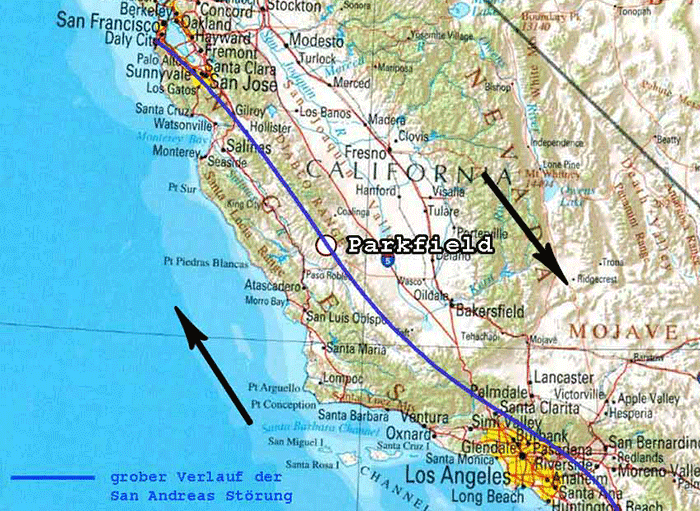Earthquake Prediction
For decades now, scientists around the world have been searching for reliable indicators of an imminent earthquake. Despite anecdotal success stories, none of the frequently discussed methods for prophesying earthquakes have turned out to be sufficiently reliable. Here are the main contenders:
Parkfield Experiment
A particularly elaborate study of possible earthquake indicators is being conducted in the USA on a 25-km-long stretch of the San Andreas Fault. The Parkfield Experiment has been running since 1985, using various instruments to measure what happens before, during and after a quake near a fault line. The San Andreas Fault is considered a suitable area to study because minor quakes are very frequent, and every 22 years (on average) an earthquake with a magnitude of 6 or more occurs there. Continuous monitoring over so many years has generated a comprehensive dataset that is being analysed by scientists the whole world over and revealing a great deal about earthquake processes. However, so far no reliable mechanism for predicting earthquakes has been found.
Animals
Again and again, abnormal animal behaviour has been touted as a harbinger of earthquakes. Yet so far no research group anywhere in the world has been able to reliably predict earthquakes based on systematic animal observation.

Documented reports of unusual catfish behaviour in the run-up to the 1855 Edo earthquake in Japan prompted a number of scientific studies. In one study, catfish movements were observed over a 16-year period. The researchers found that the catfish behaved unusually in 27 out of 87 cases (30%) in earthquakes with a magnitude of 3 or more. In one case, intensified catfish activity was observed between eight and four days before a magnitude 5.9 quake. No precise details have been published on how the 30% 'success rate' was determined and whether such warnings were effectively followed up.
Source: Ikeya, 2004
Before the Haicheng earthquake in China in 1975, snakes were seen to leave their underground holes despite the cold of winter and froze to death on the surface. Based on further observations and numerous foreshocks, the city was successfully evacuated before the earthquake occurred. Owing to the Cultural Revolution, little reliable information about these observations ever reached the public domain. And in spite of the success in forecasting the 1975 quake, there was no advance warning given before the Tangshan earthquake that occurred the following year.
Sources: Bhargava, Katiyar, Sharma, & Pradhan, 2009; Kanamori, 2001
Abnormal behaviour in rats and various other animals has been seen immediately before damaging tremors. There is a potential physical explanation for such unusual behaviour: every earthquake radiates P and S waves. P (primary) waves travel faster than S (secondary) waves, which in major quakes cause clearly noticeable, damaging tremors. Animals that already feel incoming P waves may, under some circumstances, react before the S waves arrive shortly thereafter.
Source: Bhargava et al., 2009
After the violent earthquake in the Abruzzo region of Italy in 2016, one research group fitted sensors to various animals on a farm close to the epicentre. Initial findings suggested that the animals had "clearly" reacted a few hours before the next major quake. These observations have not yet been published in any scientific journal.
Sources: Tages-Anzeiger, 20. Mai 2017 / New York Times, 17. Juni 2017
A study conducted in California investigated whether dogs tended to run away from earthquakes. To do this, over a three-year period the scientists compared the timing of thousands of missing dog reports published in a local newspaper against the 224 quakes recorded during that period. The authors found no correlation between dog disappearances and the occurrence of earthquakes.
Source: Schaal, 1988
In 1923, a Japanese professor published a study in which he described a correlation between the cries of his neighbour's pheasant and noticeable tremors. In seven cases, the pheasant cried well before the ground noticeably shook, and in four cases before tremors that were only picked up by sensitive instruments. In five cases, the pheasant crowed during the first noticeable tremors and in another five it cried too late or not at all. In the 11 cases when the pheasant cried before the tremor, it may have felt the first waves of a quake: P (primary) waves, which travel slightly faster than the S (secondary) waves accompanying tremors.
Source: Tributsch, 1978
Foreshocks
In rare cases, foreshocks presage major quakes. But it only becomes clear after the main quake that the activity in question constituted one or more foreshocks. Most major earthquakes are not indicated by earthquakes, as we know from analysing large numbers of seismological datasets.

Electromagnetic signals
Changes in electromagnetic signals are one of the most frequently debated predictors of major earthquakes. Although changes in the Earth's electrical or magnetic fields have successfully been linked to some earthquakes, different applications of the method across multiple locations and in various earthquakes have shown it to be unreliable.

Earthquake lights
There are a few - in some cases controversial - reports of unusual light effects presaging seismic activity. Such lights have been observed in the run-up to earthquakes and interpreted as warnings. However, earthquake lights are rarely observed and differ greatly in their manifestation (being described as rather small or pretty large, occurring long before or just prior to a quake or being seen near or further away from the epicentre).

Supermoons
There has been much discussion, especially in New Zealand, about whether so-called 'supermoons' can be associated with earthquakes. The initiator of this theory posited that earthquakes are triggered by the stronger gravitational forces occurring during supermoons (when the moon is closest to planet Earth). However, a scientific study concluded that only a small fraction of the changes in seismicity can be associated with such supermoons or moon phases.

Concentration of radon
Various studies and observations have indicated an increase in radon concentration in the run-up to a quake. However, such an increase is not a reliable predictor because an elevated radon concentration can only be associated with seismic activity in around 10% of cases. Furthermore, the distance between the radon measurement and the epicentre (up to 1,000 km away), the time periods in question (ranging from hours to months) and the measured magnitudes differ widely, and so far no reliable correlation between the individual parameters could be found.

Seismic gap / quiet
Seismic gap theory predicts that large earthquakes in a particular place will always occur at specific intervals. Seismic quiet theory forecasts that usual seismic activity in an area will decrease just before major quakes. Both concepts are based on comparatively simple processes in the geological underground, e.g. where different faults do not influence each other, and each quake completely dissolves the prevailing tension caused by a fault system. Neither assumption applies in the most active fault zones and there are no metrics to support either theory.

